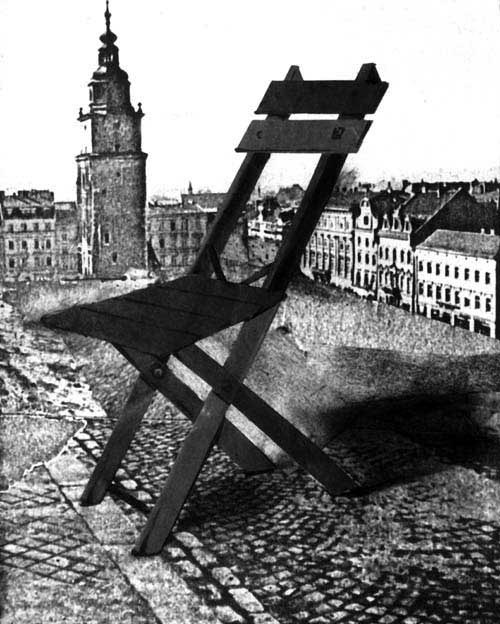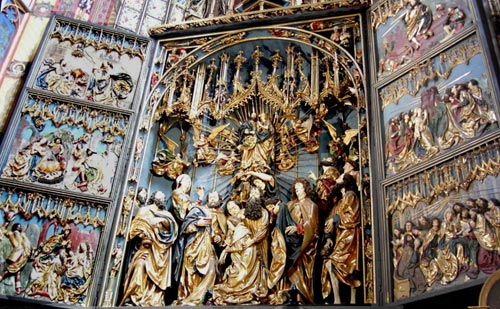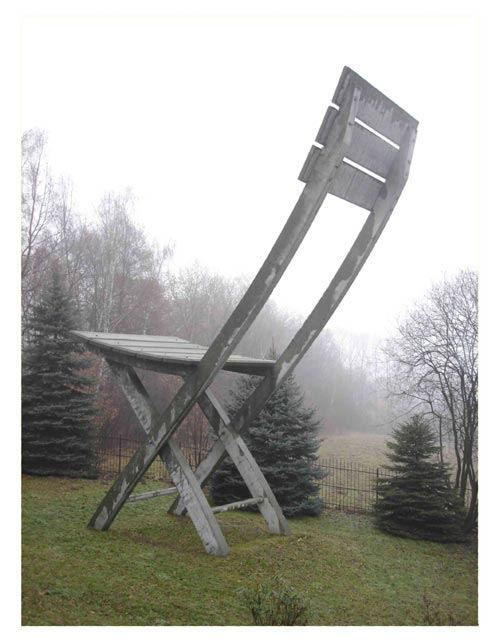

Demarco helped me in my escape by taking us to Kantor's private apartment - not generally open to the public. Here I was touched to see a cross in Kantor's diary for 7 December 1990, the day before his death (for many of his effects had not been disturbed since that time). Was it significant that Kantor had been in love with a young woman near the end of his life? Her fate haunted me and I was chilled to find her referred to as 'The Angel of Death'. Kantor's room had a cell-like simplicity - everything seemed to have its place: functional, with no fuss.
In another basement, this time in the Cricoteka, the exhibition of photographs and props seemed more like empty shells than living relics. There was no sound, and even the fabulous, brutal and cruel kinetic contraptions designed and employed by Kantor in his works were stilled and silent.
Perhaps the most important aspect of such an event is the human contacts one makes. Here we met one of Cricot 2's best-known actresses, Miroslawa (Mira) Rychlinka. Still beautiful in her 70s, Mira had played her antithesis in 'The Dead Class' - an old German man - and a host of other characters in numerous performances. Discussing 'The Waterhen', Mira observed, 'I was young. I never questioned Kantor's directions. I did what he asked. He sat me in a bath and poured cold water over me. They wrote down what I said. My shrieks became the text. My mother came to the performance. She didn't really understand what I was doing. But she saw it and after that she understood. "It's life", she said, "whether you are in Argentina, Japan or Scotland."'
Along with her son, the photographer Artur Rychlicki, Mira led us to Kantor's country house in the tiny village of Hucisko, 30 kms south of Kraków. Nothing could have prepared us for the beauty of Kantor's architectural vision. Like the man himself, the building was a blend of the traditional and the visionary - a place where the Polish vernacular material of wood embraced the values of Le Corbusier. In the garden, an impossibly vast 20 m chair (again designed by Kantor himself) did not seem incongruous, given what we know of the man. Its inspiration had come from the photomontage he had made in 1970, 'Pomnik Krzesla na Rynku w Krakowie' ('Monumental Chair in Kraków Square').
Later, in Warsaw, I visited Wieslaw Borowski, Director of the Foksal Gallery, a long-time confidant of Kantor, who Demarco described as 'the only person Kantor really trusted'. Borowski - wistful, gentle, intelligent - confirmed my feeling that the conference was of limited value and really only served to oil the academic machine: 'Kantor would have hated it. He abhorred the idea of being put in an academic box,' he confided.
In retrospect, such a comment makes even more sense. If Kantor was about anything, it was about rupturing the whole idea of static texts and performances with fixed action. He taught his actors one important credo: only in forgetting what you know do you really have the ability to create. Such radicalism is surely beyond academic scrutiny and analysis.
Giles Sutherland

